Kitchen hoods with ventilation outlet: operating principle, diagrams and installation rules
During the cooking process, the kitchen is filled with steam and food odors.All this is absorbed into the walls and furniture and negatively affects the well-being of the people in the room. Installing a kitchen hood with a ventilation outlet will ensure complete collection and discharge of exhaust air with negative volatile components.
The article we presented describes in detail the design of hoods communicating with ventilation systems. The principle of operation is thoroughly analyzed, negative and positive aspects are given. To help home craftsmen, recommendations on the selection and installation of exhaust equipment are included.
The content of the article:
Types and features of exhaust devices
The variety of hoods offered by manufacturers is sometimes amazing. On the market you can easily find a model that is optimal in cost and quality.
But for an unprepared buyer, choosing and installing such kitchen appliances will be a difficult and sometimes overwhelming task. Therefore, before going to the store or installing a hood, it is imperative to understand all the subtleties and nuances.
Sanitary standards and requirements
Any type of hood, be it a recirculation hood or a device with a ventilation outlet, must circulate a volume of air equal to 10-12 volumes of the cooking room in one hour.
This is a strict sanitary requirement that must be met.After all, open fire sources and heating appliances are actively used in the kitchen. And the humidity in the room is much higher than in other rooms.
As a result, the concentration of carbon dioxide, harmful impurities and fumes is constantly increasing, which will negatively affect human well-being.
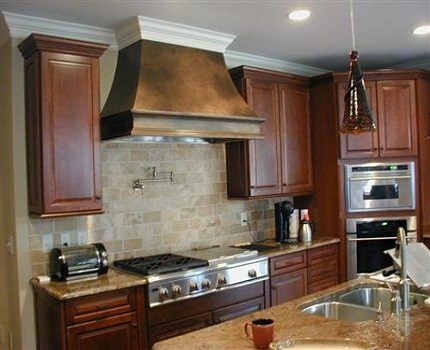
Another requirement is that the hood must be installed as close to the hob as possible. This is a minimum of 65 cm for an electric stove and 75 cm for a gas stove.
A prerequisite is the presence of a special grill on the device, where dirt and grease will settle. This will prevent waste from entering the ventilation duct.
Hood with ventilation outlet
Hoods that remove exhaust air through a ventilation shaft are the classic and most familiar models to most people. Thanks to the constant flow of fresh air, a person’s mood rises, his well-being improves, and his stay in the kitchen will become more comfortable.
Typically, exhaust devices provide forced ventilation, for which a fan is used. This approach allows you to quickly remove excess moisture from the room, which can harm the furniture set, unpleasant odors, various fumes, soot, excess carbon dioxide, etc.
In order not to pollute the atmosphere around the house, hoods use a special filter that collects most of the dirt.
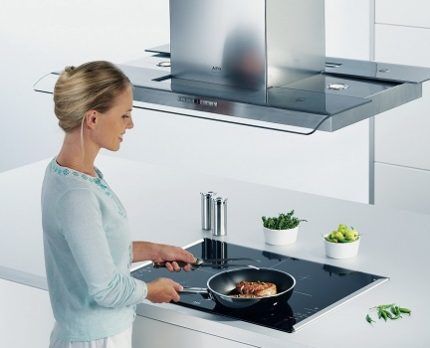
The only drawback of built-in hoods with ventilation outlet lies in the complexity of their installation. After all, the device must be connected to the air duct. If the house does not have a ventilation duct, you will have to drill a hole in the wall.
Types of hoods with outlet
There are several types of such kitchen appliances. Hoods with ventilation outlets are divided into categories depending on the design of the device, the method of installation and cleaning.
Depending on the type of installation, the following devices are distinguished:
- Mounted. They are divided into domed or flat. There are also inclined products on the market that can be unfolded if necessary. The wall-hung hood will fit harmoniously into both a large kitchen and a small room.
- Built-in. Devices of this type are an ideal solution for small apartments. Their peculiarity is that they are built into the cabinet and act as its bottom. Some devices can expand to allow more air to be captured.
Owners of large kitchens prefer the island design of the hood. It is used in situations where the stove is not located near one of the walls of the kitchen, but in the center of the room. Island hoods are attached directly to the ceiling and allow you to create an original room design.
Among other things, a device for removing exhaust air is an important element of the kitchen. It not only absorbs harmful fumes, but also acts as a decorative element.Therefore, when choosing one type or another, you need to evaluate whether the desired model will harmoniously combine with the design of the kitchen.
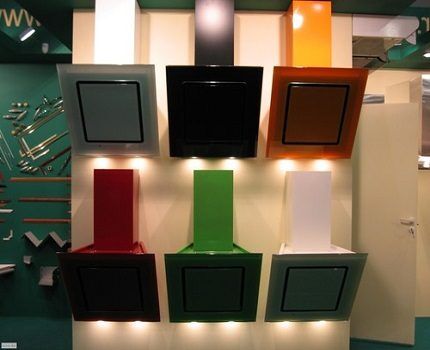
Criteria for selecting an exhaust device
The hood is one of the main elements of any modern kitchen. Therefore, its choice must be approached with all responsibility. In order not to make a mistake and buy the optimal device, you need to pay attention to a number of characteristics inherent in these devices.
Among the criteria influencing the choice are the following:
- size;
- operating modes;
- the type of filter used;
- availability of additional functions;
- body material;
- performance;
- noisiness;
- method of controlling the device.
Of course, the optimal size is extremely important when choosing a device. It directly depends on the dimensions of the hob. Therefore, before going to a household appliance store, you should definitely find out about it.
In order for a hood with air exhaust into ventilation to cope with its main task, its dimensions must correspond to or be slightly larger than the area of the gas stove. Thanks to this, the device will remove the maximum amount of fumes from the kitchen, which will significantly increase its efficiency.
As for choosing the operating mode, here you need to decide which device is needed. The fact is that hoods can operate in recirculation and air exhaust modes through the ventilation shaft, or combine 2 options.
The optimal solution would be to purchase a combined model. If the choice fell on the latter variety, then you need to ask the seller about the cost and availability of filters.

Before purchasing, you need to look at what filters are used in the hood you like. They are designed to collect most of the grease and dirt. There are several types of filters. The best solution is metal mesh. They are versatile and easy to care for – they can be washed easily.
With device and varieties carbon filters for kitchen hoods, please read the article, the contents of which we recommend that you familiarize yourself with.
As for plates made of synthetic material, this is not the best choice - they cannot be washed. Such products will have to be changed regularly, and this is an additional cost. After they have served their time, you will have to go to the store and buy new ones.
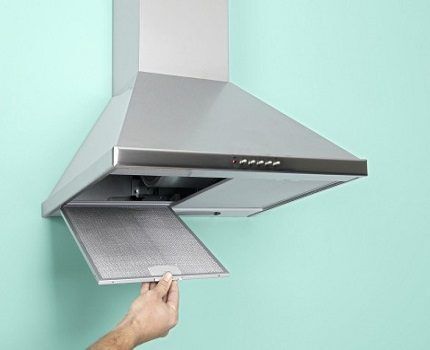
Among the additional functions of hoods, the most useful and practical is its interval mode of operation. It must be in any hood. This means that the device will turn on from time to time, purify the air and then turn off.
The vast majority of models in the mid-price range use an electronic timer to implement this function. As for more expensive products, their interval mode is based on the use of sensors that analyze the composition of the air. But such a highlight will significantly increase the cost of the hood. Therefore, before purchasing, you have to think carefully: is this function worth it?
All exhaust devices differ significantly in the material of the housing. Manufacturers offer kitchen appliances with air exhaust through ventilation made of enamel, tempered glass or stainless steel.
Before choosing a particular material, you need to remember that the durability, appearance and, of course, the cost of the device depend on it. Therefore, it is important to consider all the positive and negative aspects of each of them.
The main advantage of enameled and metal surfaces is their low cost. In addition, they can be easily washed and cleaned with a brush. To the list of features of models whose body is made of stainless steel, one should add their presentable appearance - such devices do not need to be built into a cabinet.
When it comes to tempered glass hoods, these models look simply gorgeous and cost accordingly. However, to keep them clean, you will have to regularly and carefully care for them. And you should handle such equipment with the utmost caution.
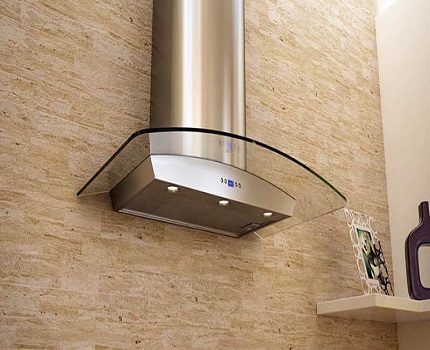
The appearance does not always correspond to the internal content. This statement also applies to kitchen hoods. Today you can easily buy device with a huge dome, the power of which is not enough to clean the air even in a small kitchen.
In order not to make a bad choice, you need to calculate the optimal performance of the device in advance. To do this, you need to find out the volume of the kitchen - multiply the floor area by the height of the ceilings.
To work comfortably indoors, you need to buy a hood that can completely renew the air in the room in 5-6 minutes. That is, in an hour the device should be able to complete 10-12 such cycles. To find out the hood performance required for your kitchen, you should multiply the volume of the room by the air exchange rate (10-12).
For example, if you take a small room with an area of 15 m2, where the ceiling height is 3 meters, then by multiplying these values, we get a volume equal to 45. Multiply this number by the air exchange rate and adding 20% as a reserve, we will find out the optimal hood power for such a kitchen. In this example, the productivity of the device should be 450-540 cubic meters per hour.
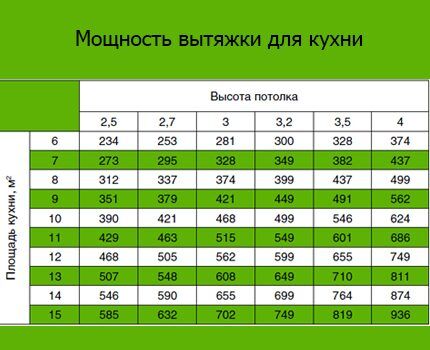
The noise level of the device plays an important role - housewives often spend several hours, and sometimes half a day, cooking. Some even install TVs in the kitchen so they don't miss their favorite movie, series or show.
It hardly needs to be said that a noisy hood will not allow you to concentrate and will not allow you to hear what the characters in the melodrama are talking about. Therefore, in order to decide on the optimal model for yourself, you need to understand the decibels.
The volume of normal human speech is 50-60 dB, while for quiet music this figure does not exceed 40 dB. As for the hood, you should look at the noise level in its technical data sheet. It should be in the range of 40-80 dB.
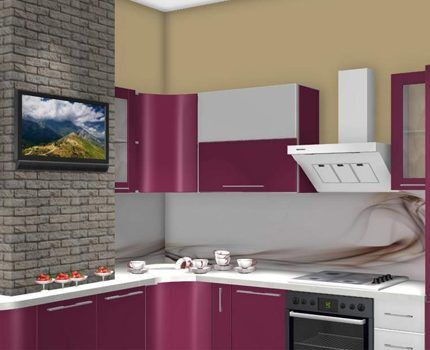
Choosing exhaust device, it is important to pay attention to how to control it. There are three types of buttons - touch, mechanical and combined. The cheapest, most simple and reliable are mechanical models. In this case, the power is adjusted using a series of special buttons or a slider (movable slider).
The touch display requires only a light touch. Such hoods look modern. The advantage of touch models is that they are easy to care for. Due to the absence of protruding elements, dirt from the display can be easily removed with a damp cloth.
Hybrid models, unlike touch and mechanical ones, are not so popular. Here the buttons are completely recessed inside the case, so you can only feel them. But caring for hybrid devices is just as easy as touch ones.
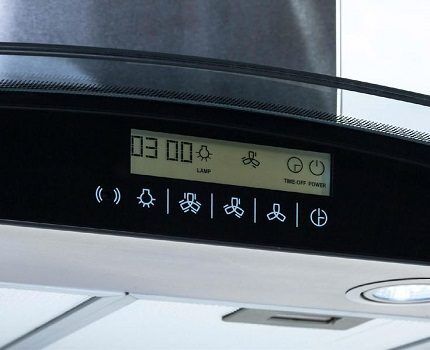
When choosing one model or another, you should definitely pay attention to the lighting option. Inexpensive hoods use regular incandescent light bulbs for this purpose. Although they are cheap, they burn out much more often. At the same time, such lighting consumes a large amount of electricity.
It is better to give preference to models that use halogen lamps. They are a more economical alternative, and they shine much brighter. But keep in mind that with such lighting, the food will take on an unnatural appearance.
The ideal option is LED lamps. They require a minimal amount of electricity and last for years.
A distinctive feature of luxury hoods with air exhaust is the presence of motion sensors. Thanks to this design solution, the light turns on if activity is detected in the area of the hob.
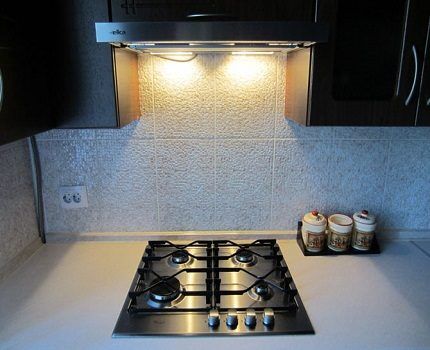
In addition to the technical characteristics, it would be useful to read the reviews of other buyers about a specific model. Numerous users who have already ordered this or that hood and managed to use it will point out the advantages and disadvantages of a particular product. This approach will allow you to weigh the pros and cons and purchase the optimal hood for your kitchen.

Hood connection rules
Selecting and buying a suitable hood for your kitchen with air exhaust into the ventilation shaft is only half the battle. It is important to correctly install the device. To avoid making mistakes, you must adhere to a certain sequence of actions.
First, immediately after purchase, you need to check the equipment of the device. The box must contain a technical passport, which contains installation instructions, an exhaust device and a set of fastening elements (screws and anchors for mounting to a brick wall).
Then it is important to prepare everything for work - a building level, a hammer drill or drill, a tape measure and a screwdriver. Then determine and mark hood height, which depends on the type of slab and its dimensions.
Next, the order of work will be as follows:
- using a tape measure, measure about 70-80 cm above the hob and use a level to draw a horizontal line;
- in the center of the previously drawn line, draw another one, perpendicular to it;
- Using masking tape, secure the template to the wall so that it does not move during drilling;
- then, using a drill and a drill corresponding to the self-tapping screws included in the kit, make four holes in the wall;
- Screws should be screwed into the wall so that their heads protrude by 0.5 cm;
- after this, remove the grille and cover from the hood and hang it on the fasteners;
- Now all that remains is to tighten the screws to the end to securely fix the device to the wall.
The installation ends with the installation of the cover and grille. Then comes the most important and labor-intensive stage - organizing ventilation. But subject to all rules and recommendations, the process hood installation will not cause absolutely any difficulties.
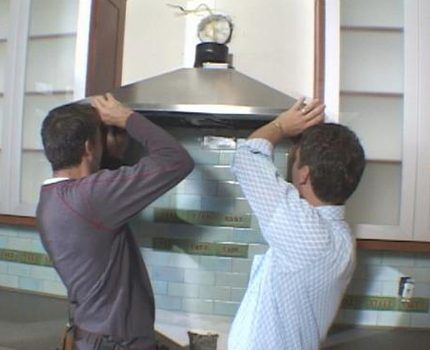
Selection and installation of ventilation ducts
There are two types of ventilation pipes for exhaust hoods: plastic products And corrugated pipes. The latter variety is in great demand, as it has many advantages.
The advantages of corrugated pipes include:
- Easy installation. The product is made of thin aluminum, thanks to which the corrugation can be bent and rotated as required.
- Ability to quickly change length. If the pipe is too long, then the excess can be cut off using ordinary scissors.And when the calculations were carried out incorrectly, the corrugation can be increased without any problems - the elements are quickly and well connected to each other.
- Light weight. The material is very light, thanks to which you can save on additional fasteners and reduce the time required for installing ventilation.
- Cheapness. A buyer with any income level will be able to afford to purchase corrugation.
But when installing this material you need to be extremely careful. After all, corrugation is very pliable and strong pressure can leave an unsightly dent on the product.
In general, it is recommended to use plastic ventilation pipes. This kind of product has a smooth inner surface, so the flow will not be slowed down by the walls and lose its speed. In addition, the material is inexpensive, lacks elements susceptible to oxidation, and is safe for human life and health.
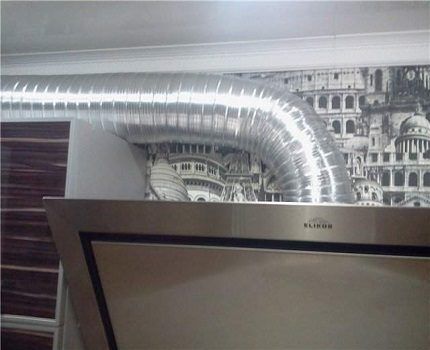
Where is the best place to place the outlet?
The hood consumes a considerable amount of electricity during its operation. Therefore, experts recommend installing a separate line for the device, since otherwise the entire network may not withstand such voltage.
The socket should be located directly next to the device itself. Please note that if a gas stove is used for cooking, the outlet must be at a safe distance from it.
Hood care rules
In order for the device to last for a long time, it must be cleaned regularly.Before washing the hood, it must be de-energized. Next, you need to remove the grille or filter and wash all parts of the device on which dirt may have accumulated. To clean, you can use dish soap or a special composition designed for stainless steel products.
A distinctive feature of modern materials is their ease of washing. But sometimes, in case of severe contamination, you need to use a detergent. Please note that it is forbidden to use powder, a metal sponge or a scourer with a hard fiber structure for cleaning - they will scratch the surface of the hood.
To wash the buttons, use a soft cloth soaked in a cleaning solution. After all the elements of the hood are perfectly cleaned and the surface of the device is wiped dry, the device can be plugged in and continue to operate.
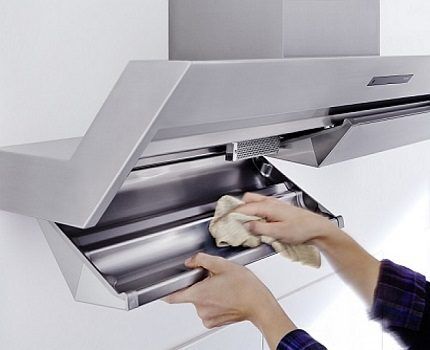
Conclusions and useful video on the topic
Video #1: Tips for choosing a hood for the kitchen:
Video #2: Detailed analysis of the installation of a hood with air exhaust into the ventilation shaft:
Video #3: Installing a kitchen hood duct:
A kitchen hood with air exhaust into the ventilation is an irreplaceable appliance that you should think about buying first. After all, once you spend money and understand in detail the types of exhaust devices, you can ensure that brand new wallpaper and stretch ceilings do not absorb various unpleasant odors, and the cooking process itself brings only pleasure.
Please write comments and ask questions in the block below.Tell us how you chose exhaust hood equipment to design your own kitchen. Leave posts with your opinion on the issue, post photos related to the topic of the article.




First of all, you need to decide on the choice of hood. We must remember about the design of the kitchen, its dimensions and the size of the hob. I was lucky, the apartment already had shafts for removing air from the kitchen. All that was left to do was to purchase the necessary hood, assemble and install it. I bought a combined model (recirculation and exhaust mode), which is almost silent. Hung it at a height of 70 cm above the hob.
In our kitchen we constantly smell food from our neighbors. Ventilation is normal, natural type with a grille without a fan. I talked with specialists - they say that this is due to improper installation of hoods in adjacent apartments, and that this should not be the case. In general, it is not recommended to place the box in the ventilation. But where should we take him out then? Maybe the neighbors just installed something incorrectly? Is there any way to solve the problem? Kitchen smells from neighbors are sometimes so specific...
Apparently you have a problem with the reverse draft of the ventilation. Bring a candle or match to it and look in which direction the light is tilted. If it’s yours, call the management company, have them send a person and see what’s going on.
Don't listen to people who suggest putting matches near the kitchen vent! Do you know how easily a mixture of grease and dust can ignite, given that grease from the hood accumulates in the ventilation duct for years? To check the normal ventilation draft, just tear off a piece of toilet paper (everyone has it) and lean it against the ventilation hole. Any other piece of paper will do.
If there is reverse draft, then call the management company and let them fix this problem, there may be several reasons for this, including improper installation of ventilation equipment in the neighbors.
It’s just that I personally know of one case when a neighbor set fire to a ventilation duct while checking the draft with a lighter, it blazed very effectively, a mixture of grease and dust is no joke!
I have a question about hoods with outlets. The above does not indicate that exhaust requires an inflow in the same volume as the contaminated air exits into the ventilation duct, and the inflow means either opening a window or installing an additional supply fan.
In both cases, in winter it is cold when the hood is used, and the recirculation hoods require constant filter replacement, and when passing through the filter, up to 40% of the productivity of the hood volume is lost.
And then you don’t know what to choose - either freeze in winter, or constantly change these filters. Is there any best option for a small budget?
Marina, I don’t think you need to install additional supply ventilation. This is a kitchen in an apartment, not a production facility where equipment is used all day.
Hoods with ventilation outlets work great even without additional air flow. If you still need to provide additional air flow in the kitchen, then an open window for ventilation is the best option.
There is no need to spend money on installing additional ventilation equipment. When you cook something in the kitchen, the temperature in the room rises. Opening a window for ventilation will not in any way affect the temperature drop significantly; 2-3 degrees is the maximum. If this is critical for you, then you can open a window in another room where you are not currently located.
And there are hoods with a rear outlet that can be directly removed through the wall in a dacha...